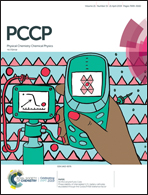What accounts for the color purity of tetradentate Pt complexes? A computational analysis†
Abstract
In order to improve the texture of human visual perception and broaden the range of certain optical applications, many phosphorescent complexes exhibiting narrow emission spectra have been prepared through reasonable molecular design. For example, by adding a particular group such as tert-butyl (tbu) to a suitable position of PtON1 and PtON7, the peak width of a relevant vibronic band caused by the specific vibrational normal modes could be dramatically restrained in the emission spectra at room temperature. For the purpose of finding an effective approach to replace the trial-and-error manner, the microscopic mechanism of such high color purity was elucidated by computational investigation. In this study, we aim to identify the reason that causes sharp emission associated with the relevant vibrational normal modes. Here, these modes can be labeled to the emission peak by the vibrationally resolved emission spectra. Based on the displacement vectors of relevant normal modes and the vibrationally resolved spectra, the most possible reason for the higher color purity is that tbu in a specific location can restrain the structural deformation between the first triplet excited state (T1) and the ground state (S0). That is to say, the relevant Huang–Rhys factor (Sk) of specific vibrational modes would be decreased. For these compounds, the total bandwidth and the height of the intermediate and high-frequency regions which are in direct proportion to Sk would be decreased to obtain the higher color purity by tbu in a particular position. What is more, the best position for tbu in order to suppress the structural deformation was also considered. In the meantime, radiative (kr) and nonradiative (knr) decay rates of T1 were investigated to seek the effective phosphorescent complexes.



 Please wait while we load your content...
Please wait while we load your content...